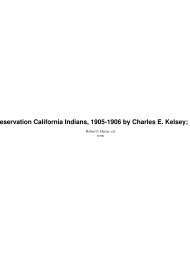YA summer '01 - Yosemite Online
YA summer '01 - Yosemite Online
YA summer '01 - Yosemite Online
Create successful ePaper yourself
Turn your PDF publications into a flip-book with our unique Google optimized e-Paper software.
FROM V TO U—GLACIATION<br />
AND VALLEY SCULPTURE<br />
BY N. KING HUBER<br />
Glaciers are powerful agents of erosion, capable of<br />
greatly modifying the landscape. The Sierra<br />
Nevada has undergone multiple glaciations,<br />
although the exact number is unknown. Most of the glacial<br />
sculpture in the Sierra, however, was accomplished<br />
during the earliest and most extensive glaciation, known<br />
as the Sherwin glaciation, which ended a million years<br />
ago and may have lasted as long as 300 thousand years. 1<br />
At that time the granitic rocks that make up the bulk of<br />
the range were deeply weathered and offered little resistance<br />
to glacial excavation. Later glaciers, generally<br />
smaller, had to deal with the fresher and more resistant<br />
rock that was exposed by the action of Sherwin glaciers,<br />
and they were largely limited to “clean-up” activities,<br />
such as the removal of rock debris, or talus, that had<br />
tumbled from valley slopes during interglacial periods.<br />
Glaciers in mountainous terrain, such as the Sierra<br />
Nevada, largely follow and modify pre-existing stream<br />
valleys. Glaciated valleys tend to differ from normal<br />
stream valleys in two important ways. First and foremost,<br />
glaciated valleys tend to be straighter and less<br />
meandering than unglaciated stream valleys. Secondly,<br />
they tend to develop a U-shaped cross-profile rather<br />
than the V-shaped cross-profile characteristic of stream<br />
valleys beyond the reach of Sierran glaciers. Compare,<br />
for example, Hetch Hetchy Valley (Figure 1) with the<br />
canyon of the Merced River immediately below El Portal<br />
(Figure 2). Why this difference in form? Although existing<br />
pre-glacial rock structures playa part, this difference<br />
in form? Although existing pre-glacial rock structures<br />
play a part, the difference is largely due to the differing<br />
physical nature of the sculptors, water and ice.<br />
River water, with its extreme fluidity, can flow fast<br />
enough so that its inertia, or resistance to change in<br />
direction, forces the water against the outside of river<br />
bends where it moves fastest. Thus rivers tend to erode<br />
the outside of their bends and to deposit sediment on<br />
the inside where the water flows more slowly. This<br />
behavior is beautifully illustrated by the meander pattern<br />
of the Merced River on the present <strong>Yosemite</strong> Valley floor.<br />
There the river has a low gradient, or slope, and is cutting<br />
into easily eroded alluvial materials only on the outside<br />
of river bends. Even in hard bedrock, a mountain<br />
river with high energy can cut deep canyons with<br />
entrenched meanders that remain sinuous, such as on<br />
the Merced River below El Portal.<br />
In contrast, ice flows as a plastic solid. Glaciers move<br />
so slowly that inertial forces are negligible. A glacier will<br />
flow fastest, and erode fastest, where its surface slope is<br />
steepest, other things being equal. If a glacier occupies a<br />
sinuous valley cut by a river, the ice surface tends to drop<br />
more steeply on the inside of bends than on their outer<br />
sides (Figure 3). Thus the fastest flow of ice tends to be<br />
on the inside of bends. Hence the inside of bends in the<br />
bed of a glacier tend to erode rapidly, and over time the<br />
glacier will tend to remove the topographic spur, or<br />
ridge, that forms the inside of the bend. In the process of<br />
eliminating the original valley spurs, the glacier not only<br />
straightens the valley, but modifies the V-shape by<br />
broadening the valley floor.<br />
Additional insight into the form of glacial valleys can<br />
be gained by examining the mechanics of glacial erosion.<br />
In considering the interaction of flow of plastic material,<br />
such as ice, with the frictional effects of the walls of a rel-<br />
Figure 1. Glaciated Hetch Hetchy Valley, with its broad, open<br />
floor (NPS Archives).<br />
Figure 2. Unglaciated Merced River canyon below El Portal, with<br />
its pronounced V-shaped cross-profile (Dallas L. Peck).<br />
6 YOSEMITE ASSOCIATION, FALL 2003




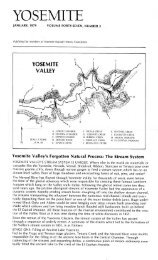
![(March 1982) [PDF] “We Are Pleased to Announce†- Yosemite Online](https://img.yumpu.com/51299748/1/190x242/march-1982-pdf-aeuroewe-are-pleased-to-announceaeur-yosemite-online.jpg?quality=85)
![[PDF] Old Horny, Yosemite's Unicorn Buck - Yosemite Online](https://img.yumpu.com/51269869/1/184x260/pdf-old-horny-yosemites-unicorn-buck-yosemite-online.jpg?quality=85)
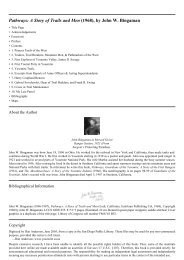
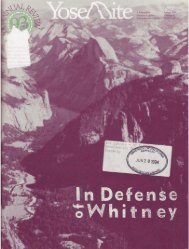
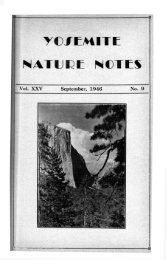
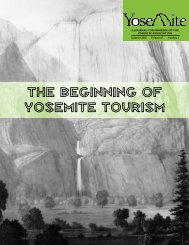
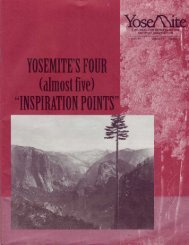
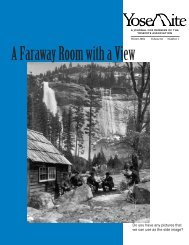
![1985 [PDF] - Yosemite](https://img.yumpu.com/48128837/1/184x260/1985-pdf-yosemite.jpg?quality=85)

